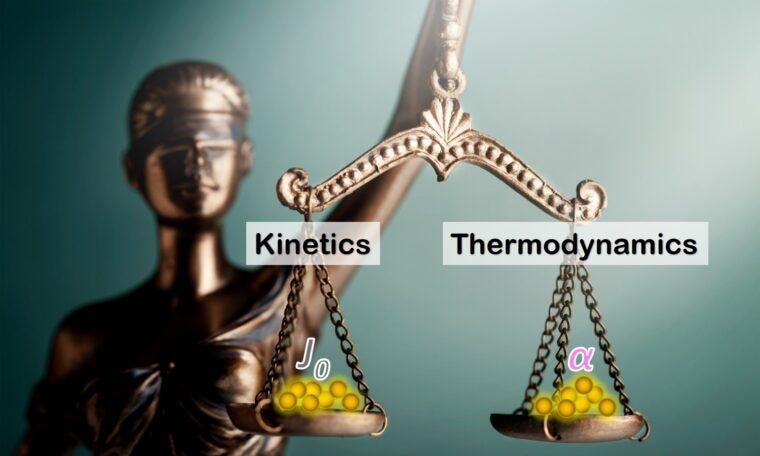Jul 2 2019
Calcium carbonate (CaCO3) formation in water has implications in everything from energy and food production to human health and the availability of potable water. But in the background of present-day environment, just exploring how calcium carbonate develops in pure water is not useful.
 Research from the McKelvey School of Engineering suggests that without considering certain factors, researchers may overestimate how fast calcium carbonate forms in saline environments. (Graphic credit: McKelvey School of Engineering)
Research from the McKelvey School of Engineering suggests that without considering certain factors, researchers may overestimate how fast calcium carbonate forms in saline environments. (Graphic credit: McKelvey School of Engineering)
Scientists at Washington University in St. Louis’s McKelvey School of Engineering have initiated advanced techniques to investigate the creation of calcium carbonate in saline water. Their results, recently reported in the Journal of Physical Chemistry C, propose that, without taking into account the kinetic factors, researchers may have been misjudging how rapidly calcium carbonate develops in saline environs.
“Now more than ever, it is important to understand how minerals form under highly saline conditions,” said Young-Shin Jun, professor in the Department of Energy, Environmental & Chemical Engineering. As urban areas expand, a lot more freshwater is lost to the oceans through runoff. An increased production of briny water is also being observed in energy harvesting and industrial processes, such as hydraulic fracturing and desalination.
Jun’s team started with a philosophical question: when exactly does the coming together of calcium and carbonate ions “form” calcium carbonate?
“People often casually say ‘formation’ when they refer to the ‘growth’ of solids, but formation actually starts earlier, at the nucleation stage,” Jun said. “Nucleation begins at the moment when all of the precursor parts have fallen into place, reaching a critical mass that creates a nucleus that is big enough and stable enough to continue to grow as calcium carbonate solids.”
Nucleation is, expectedly, hard to see because it occurs at the nanoscale. Hence, this process is frequently just assumed to have happened. Instead of paying attention to nucleation as an isolated occurrence, scientists have traditionally placed more importance on comprehending growth.
Working in northern Illinois at the Advanced Photon Source in the Argonne National Laboratory with an extremely robust synchrotron-based X-ray scattering technique called grazing incidence small angle X-ray scattering (GISAXS), Jun’s lab has developed unique environmental reaction cells and witnessed real-time nucleation events in aqueous settings. They can observe the moment of nucleation, which enables them to carefully compare rates of nucleation in waters with varying salinities.
The concentration of salt in water differs extensively; seawater has roughly 35 g of salt per liter, while water used in hydraulic fracturing (or fracking) has even higher concentrations of salts. However, without looking into salinity, a majority of studies have investigated how the mineral interacts with the substrate on which it forms — for instance, what is a water pipe or a membrane composed of, and how does that material impact the development of calcium scales?
But those are not the only critical interactions.
“We need to add salinity into this matrix,” Jun said. “How does saline water chemistry affect nucleation? It doesn’t happen in a vacuum.”
A crucial relationship in establishing the probability of nucleation is the balance between the kinetics and thermodynamics of the specific system. In thermodynamics, a specific amount of energy is vital to trigger nucleation; if that energy (termed as the interfacial energy) is adequately low, then nucleation can freely take place.
Kinetics talks about the motions of the sub- and nanometer-sized building blocks (precursors) that may or may not realize that critical mass (known as the critical nucleus size) and continue to grow as calcium carbonate. As with nucleation itself, detecting the kinetics of these particles is hard. Historically, the kinetic factor was said to be less crucial than the thermodynamic factor, and was presumed to be a constant. But is this true for extremely saline water as well?
“People have thought that kinetics is not important because it should be the same, no matter what,” Jun said. But using GISAXS, Jun and her former doctoral student Qingyun Li, currently at Stanford University, were able to quantitatively illustrate the association between the kinetic factor (J0) and thermodynamic parameter (interfacial energy, α) of calcium carbonate nucleation, using quartz as the substrate. Critically, they were able to test it in water with a range of salinities.
In fact, in water with high salinity, interfacial energy is lesser than in pure water, which means nucleation can occur easier. However, the kinetic factor — in relation to how rapidly the building blocks are being delivered — is slow.
“If we account only for thermodynamics when we predict the system, we’re overestimating the rate of nucleation. The impact of kinetic factors should be included,” Jun said.
This impact is essential for numerous reasons beyond just having a better basic insight into mineral formation.
Unprecedented socioeconomic development has accelerated our fresh water needs. Also, a large volume of super-saline water is generated from water and energy recovery sites, such as desalination plants and conventional/unconventional oil and gas recovery using hydraulic fracturing.
Young-Shin Jun, Professor, Department of Energy, Environmental & Chemical Engineering, Washington University
She added, “Thus, to design sustainable water and energy production systems, we urgently need a good understanding of how highly saline water can affect calcium carbonate nucleation, which can reduce their process efficiencies.”
It is an exciting finding. By changing the kinetics and thermodynamics, we can design a surface to prevent nucleation. By knowing when and where the nucleation happens, we can prevent or reduce it, extending the lifetime of pipelines or water purification membranes. Conversely, we can also increase nucleation where we need it, such as in geologic CO2 storage. This basic understanding gives us power and control.
Young-Shin Jun, Professor, Department of Energy, Environmental & Chemical Engineering, Washington University